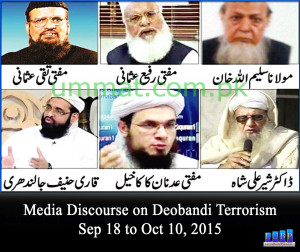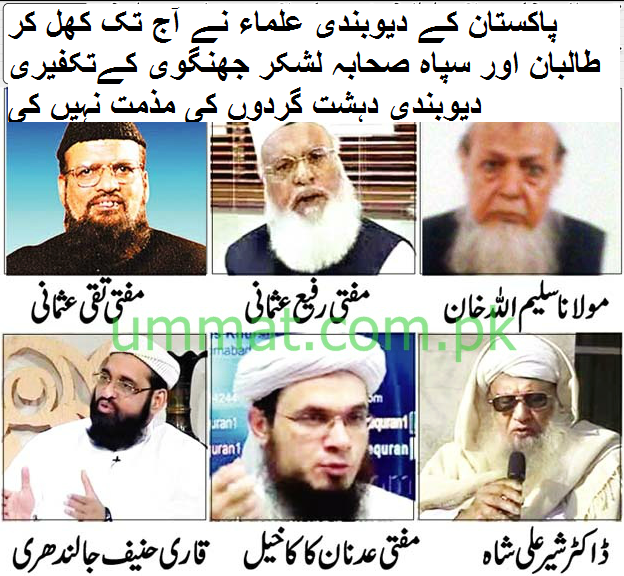Media Discourse on Deobandi Terrorism – Sep 18 to Oct 10, 2015
Modern Muslims are coming forward against ‘Whimsical Fatwas’
Let us look at the back ground and history of the Raza Academy. It is quite interesting. We know that Muslims, both Shias and Sunnis are divided into several School of Thoughts, the sects, the sub-sects and free thinkers. The most powerful Indian School since it is backed by Saudi Petrodollar is Deobandi. These Deobandis disapprove of praying at Dargahs (graves of Sufi saints) while Barelvis it is a very central practice. Rest is not very clear. But the rift is far and wide.
Source:
The Foreign Policy Essay: Al Qaeda’s Re-launch in South Asia
September 21, 2014
Lawfare
While no al-Qaeda members of any consequence were killed in the cruise missile attacks, several Pakistani militants associated with Harkat-ul-jihad-e-Islami (HuJI) and Harkat-ul-Mujahideen (HuM) were. Both organizations are associated with the Deobandi interpretive tradition as are the Afghan Taliban and numerous other groups. HuJI and HuM were not the only Deobandi Pakistani groups to be co-located with the Taliban: the anti-Shi’a organizations Sipah-e-Sahaba-e-Pakistan (SSP) and Lashkar-e-Jhangvi (LeJ) also fled to Afghanistan in the 1990s to help the Taliban consolidate its hold over Afghanistan. Through this co-location with the Taliban, HuJI, HuM, SSP and LeJ forged ties with al-Qaeda.
When the Americans invaded, al-Qaeda and the Taliban leadership fled to Pakistan along with fighters from these Pakistani organizations. From 2001 onward, numerous senior leaders of al-Qaeda were captured in Pakistan purportedly with Pakistani assistance. While some writers, such as Bruce Reidel, argue that Pakistan’s army and its premier intelligence agency, the Interservices Intelligence Directorate (ISI), have been tightly allied with al-Qaeda, I do not share this view. From late 2001, al-Qaeda’s Deobandi allies began targeting the Pakistani state. By 2003, al-Qaeda denounced Pakistan’s then-military dictator and self-styled president, Pervez Musharraf, as a “traitor.” Later, in 2004, al-Qaeda encouraged Pakistanis to topple his government. In 2007, Bin Laden declared war on Pakistan.
From 2001 onward, many of the attacks that took place in Pakistan were imagined by al-Qaeda but executed by its Pakistani Deobandi “subcontractors” such as the LeJ and other groups. Al-Qaeda allies such as Jaish-e-Mohammad (JeM, another Deobandi group derived from HuJI and HuM) conducted numerous attacks in India. The most notorious was JeM’s December 2001 assault on India’s parliament, which brought India and Pakistan to the brink of war. These Pakistani Deobandi organizations facilitated al-Qaeda’s operations in Pakistan and even provided fighters. (In contrast to these Deobandi militants, Lashkar-e-Taiba—Pakistan’s most notorious terrorist organization—did not co-locate with the Taliban, maintained their own distinct training facilities in Afghanistan, and did not form these operational ties to al-Qaeda.)
Ironically, in the case of Pakistan and even Bangladesh, the violence against Muslims is perpetrated by Muslims themselves. Militants tied to Pakistan’s own Deobandi Taliban organization (Tehreek-e-Taliban-e-Pakistan, or TTP, and sectarian groups like LeJ/SSP) have slain thousands of Pakistanis in uniform as well as civilians who espouse versions of Islam that the TTP denounces. In Bangladesh, militants have killed Sufis and Ahmadis as religious intolerance spreads in that country. In an early 2014 speech, Zawahiri encouraged Bangladeshis to engage in an intifada. In that speech, he declares that the bloodbath in both countries is due to “India, the corrupt leadership of the Pakistan army, and treacherous power hungry politicians of Bangladesh and Pakistan.”
The Islamic State is not the only competition that Zawahiri is likely eyeing. For years, the preeminent terror organization operating in South Asia has been Lashkar-e-Taiba (LeT). Although LeT claims to be a transnational jihadi organization, for most intents and purposes, LeT restricts itself to India and Afghanistan. This is due to its long-standing ties with Pakistan’s intelligence agency, the ISI. Despite the fact that LeT follows the Ahl-e-Hadis interpretative tradition of Islam, which shares some affinity with al-Qaeda’s Salafist orientation, LeT and al-Qaeda have not been collaborators as many like to suggest. If anything, they have been competitors for the hearts and minds of South Asia. While al-Qaeda neglected Kashmir and India’s Muslims, LeT made this population a mainstay of its activities. No other organization in South Asia—apart from al-Qaeda—can plan and execute complex and coordinated attacks like LeT, which garnered international fame for its November 2008 multi-day siege on India’s mega port city of Mumbai. While LeT’s literature speaks of global jihad, the organization has perforce restricted itself to the South Asian subcontinent. Unlike rival Deobandi militant groups, LeT has never conducted any attacks in Pakistan, likely owing to its deep alliance with the Pakistani state. LeT has even denounced such anti-state activity in its publications, which only strengthens its utility to Pakistan’s deep state.
Source:
https://www.lawfareblog.com/foreign-policy-essay-al-qaedas-re-launch-south-asia
While ruminating on the spectre of terrorism in the wake of Badaber incident in Peshawar, the central focus of discussion with a few students was the concept of nation-state and its dissonance with the political creed of the Pakistani religious right, particularly Deobandi groups.
Needless to say that most, if not all, militant groups unleashing terror on Pakistan and its citizens adhere to the Deobandi denomination.
His line of reasoning suggested Jamaat-i-Islami as the focus of his attention, which is slightly different in its political orientation than the Deobandis. It should not however, blind us to the commonalities between the two groups and their respective ideologies.
Simultaneously, the centrality accorded to the text and particularly to Hadith in the Islamic epistemology went a long way to marginalise local versions of Islam and brought into prominence a scriptural version. Deobandi denomination epitomised the scriptural interpretation of Islam. Ulema like Imdadullah Muhajir Makki, Rahmatullah Kairanwi and later on Anwar Shah Kashmiri played a role in bringing local version(s) of Islam in line with the way it was practised and professed in Hijaz and Egypt.
An important question remains regarding this political vision, which is essentially pan-Islamic, hence antithetical to the very idea of a state. Therefore when Deobandis are launching attacks on state installations, they in fact are acting in accordance with their political ideology, one which transcends national frontiers or socio-cultural particularities.
Source:
http://tns.thenews.com.pk/pan-islamism-nation-state-pakistan/#.ViHpgFLLfcR
In defence of Sanatan Sanstha: It is no ISIS
The Bhatkal branch of the Nadwa seminary is alleged to have played a role in radicalising the local Muslim youth. Most terrorists of Indian Mujahideen (IM ) either studied in the madarsas of Ahle Hadis branch of Indian Wahabism or were its followers. Ahle Hadis is the Wahhabi sect followed by Lashkar-e-Taiba. Amongst the three Wahabi streams, Ahle Hadis, Deoband and Nadwa, Ahle Hadis is considered to be the closest to mainstream Wahabism when it comes to Islamic tenets.
It is surprising that all those calling for a ban on Goa-based Hindu organisation Sanatan Sanstha, following the arrest of one of its members on the charge of murdering rationalist Govind Pansare in Maharashtra, never asked for a ban on either the chief Deoband madarsa at Deoband or the Nadwa madarsa at Lucknow or the Ahle Hadis madarsa at Saharanpur, despite a majority of terrorists having studied in the seminaries, which are part of the networks of these three Wahhabi schools of thought. Significantly, in all these Wahabi madarsas, Mughal emperor Akbar, the secular hero of Indian liberals, is portrayed as a heretic because Akbar espoused liberal ideas vis-a-vis Hindus.
Source:
Islam must be separated from the niqab issue
Mohamad Jebara
October 10, 2015
Ottawa sun
In fact, those who consider face veils a “religious” article are two sects: the Salafis (Wahhabi) and Deobandis. Therefore to declare the face veil “Islamic” would be like stating that polygamous communities are a “Christian phenomenon” despite the fact that only a minority offshoot of Mormons practice it. Or that flagellation during Easter is a “Christian practice”, because a minority among the Philippines’ Catholics do it.
Source:
http://www.ottawasun.com/2015/10/10/islam-must-be-separated-from-the-niqab-issue


